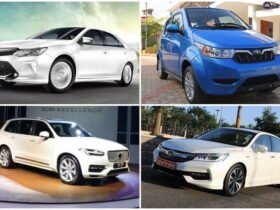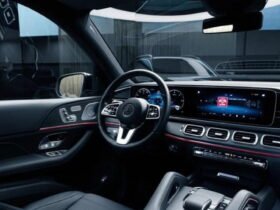A four-stroke (also four-cycle) engine is an internal combustion (IC) engine in which the piston completes four separate strokes while turning the crankshaft, unlike a two-stroke engine which works on a two-cycle. A stroke refers to the full travel of the piston within the cylinder, in either direction. This type of engine works on the otto cycle. A four-stroke engine can be a petrol engine or a diesel engine.
Nikolaus Otto was the first person who designed the four-stroke engine in 1876.
Working of Four Stroke Petrol Engine
The working of this engine is performed in four separate strokes. Each stroke has the following meaning:

Intake
This stroke is also known as induction or suction. This stroke of the piston begins at the top dead center (T.D.C.) and ends at the bottom dead center (B.D.C.). In this stroke, the intake valve must be in the open position while the piston pulls an air-fuel mixture into the cylinder by producing vacuum pressure into the cylinder through its downward motion. The piston is moving down as air is being sucked in by the downward motion against the piston.
Compression
This stroke begins at B.D.C, or just at the end of the suction stroke, and ends at T.D.C. In this stroke, the piston compresses the air-fuel mixture in preparation for ignition during the power stroke. Both the intake and exhaust valves are closed during this stage.
Combustion
Also known as power or ignition. This is the start of the second revolution of the four-stroke cycle. At this point, the crankshaft has completed a full 360-degree revolution. While the piston is at T.D.C. (the end of the compression stroke) the compressed air-fuel mixture is ignited by a spark plug forcefully returning the piston to B.D.C. This stroke produces mechanical work from the engine to turn the crankshaft.
Exhaust
Also known as an outlet. During the exhaust stroke, the piston once again returns from B.D.C. to T.D.C. while the exhaust valve is open. This action expels the spent air-fuel mixture through the exhaust valve.
Working of Four-Stroke Diesel Engine
Intake
This stroke is the suction stroke. This stroke of the piston begins at the top dead center (T.D.C) and ends at the bottom dead center (B.D.C). In this stroke, the intake valve must be in the open position while the piston pulls an air-fuel mixture into the cylinder by producing vacuum pressure into the cylinder through its downward motion.
Compression
This stroke begins at the bottom dead center and ends at the top dead center. The piston compresses the air-fuel mixture. Both intake and exhaust valves are closed during the compression stroke.
Combustion
This is sometimes referred to as a power stroke as the power is generated during this stroke. At this point, there is a 360-degree rotation of the crankshaft While the piston is at the top dead center the compressed air-fuel mixture is ignited by highly compressed air (hot air) resulting in the piston returning to the bottom deck center.
There is no spark plug to ignite the fuel as it is not necessary in this case. This stroke produces power that’s why the name is power stroke which is used to rotate the crankshaft.
Exhaust
Last part of 4 strokes. During the Exhaust stroke, the piston once again returns from the bottom dead center to the top dead center while the exhaust valve is open. This action suspends the air-fuel mixture through the exhaust valve in the form of gases.
The basic difference between four-stroke petrol engine and four-stroke diesel engine is the burning of the air-fuel mixture. In a petrol engine, it is ignited by a spark plug and whereas in a diesel engine, it is due to highly compressed air (hot air) and no spark plug is present.
Applications
- Widely used in the automobile industry.
- Used in cars, bikes, trucks, buses, scooters, etc.
Advantages
- Four-stroke petrol or diesel engine has higher torque at lower rpm as compared to two-stroke engine.
- More fuel efficient than a two-stroke engine.
- It creates less pollution as no oil is burned during combustion.
- This engine lasts longer than two-stroke engine as they are designed for high rpm and at high rpm engines wear at a faster rate hence less durable.
- It has a separate oil chamber.
Disadvantages
- It has more reciprocating parts which ultimately leads to complicated design.
- Manufacturing is expensive.
- Power generation is somewhat less than 2 stroke engine as power gets delivered once every 2 rotations of the crankshaft.










The sentence “while the piston pulls an air-fuel mixture into the cylinder” is not appropriate since in a diesel engine the fuel is injected into the compression chamber later, at the next DTC, initiating the combustion process.
Thanks for the information. We will update it.